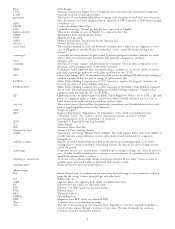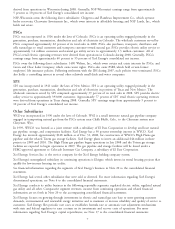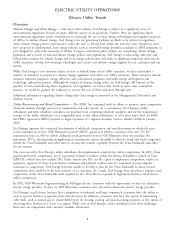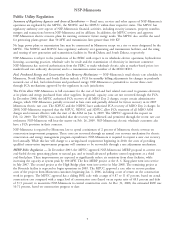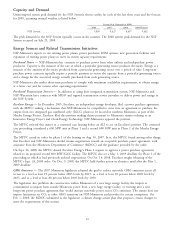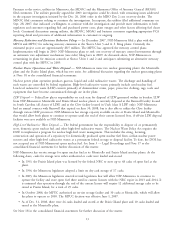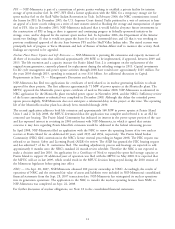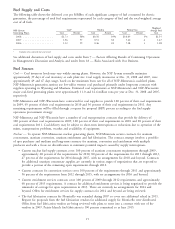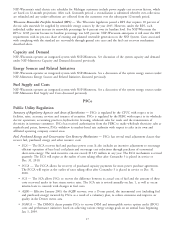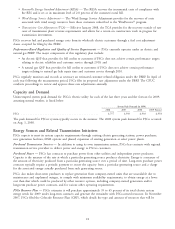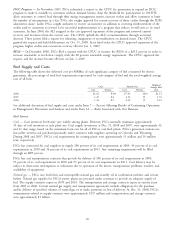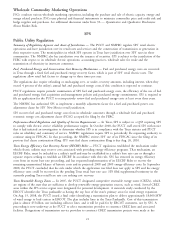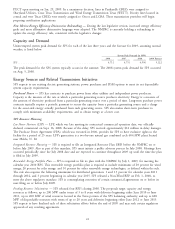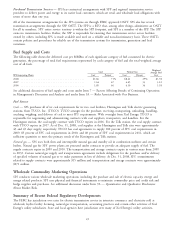Xcel Energy 2008 Annual Report Download - page 23
Download and view the complete annual report
Please find page 23 of the 2008 Xcel Energy annual report below. You can navigate through the pages in the report by either clicking on the pages listed below, or by using the keyword search tool below to find specific information within the annual report.Pursuant to the notice, utilities in Minnesota, the MDOC and the Minnesota Office of Attorney General (MOAG)
filed comments. The utilities generally argued the 2003 investigation could be closed, with remaining issues addressed
in the separate investigation initiated by the Dec. 20, 2006 order in the MISO Day 2 cost recovery docket. The
MDOC filed comments seeking to continue the investigations. In response, the utilities filed additional comments on
Sept. 28, 2007, that indicated a willingness to continue with the investigation and provide more information to both
regulators and customers regarding fuel and purchased power costs, plant outages and other factors affecting fuel clause
levels. Continued discussions among utilities, the MDOC, MOAG and business customers regarding appropriate FCA
reporting detail and provision of additional information to customers is ongoing.
Mercury Reduction and Emissions Reduction Filings — In December 2007, NSP-Minnesota filed a plan with the
MPCA and MPUC for reducing mercury emissions at the Sherco Unit 3 and A. S. King plants. Currently, the
estimated project costs are approximately $8.5 million. The MPUC has approved the mercury control plans.
Implementation will begin in 2009. NSP-Minnesota plans to seek cost recovery of mercury control investments through
an automatic rate adjustment mechanism (rate rider) filing later in 2009. As discussed above, NSP-Minnesota is
reexamining its plans for emission controls at Sherco Units 1 and 2 and anticipates submitting an alternative mercury
control plan with the MPUC in 2009.
Nuclear Power Operations and Waste Disposal — NSP-Minnesota owns two nuclear generating plants: the Monticello
plant and the Prairie Island plant, which has two units. See additional discussion regarding the nuclear generating plants
at Note 18 to the consolidated financial statements.
Nuclear power plant operation produces gaseous, liquid and solid radioactive wastes. The discharge and handling of
such wastes are controlled by federal regulation. High-level radioactive wastes primarily include used nuclear fuel.
Low-level radioactive waste (LLW) consists primarily of demineralizer resins, paper, protective clothing, rags, tools and
equipment that have become contaminated through use in the plant.
LLW Disposal — Federal law places responsibility on each state for disposal of LLW generated within its borders. LLW
from NSP-Minnesota’s Monticello and Prairie Island nuclear plants is currently disposed at the Barnwell facility located
in South Carolina (all classes of LLW) and at the Clive facility located in Utah (class A LLW only). NSP-Minnesota
had an annual contract with Barnwell that expired on June 30, 2008, but is also able to utilize the Clive facility
through various LLW processors. NSP-Minnesota has storage capacity available on-site at Prairie Island and Monticello
that would allow both plants to continue to operate until the end of their current licensed lives, if off-site LLW disposal
facilities were not available to NSP-Minnesota.
High-Level Radioactive Waste Disposal — The federal government has the responsibility to dispose of, or permanently
store, domestic spent nuclear fuel and other high-level radioactive wastes. The Nuclear Waste Policy Act requires the
DOE to implement a program for nuclear high-level waste management. This includes the siting, licensing,
construction and operation of a repository for domestically produced spent nuclear fuel from civilian nuclear power
reactors and other high-level radioactive wastes at a permanent federal storage or disposal facility. To date, the DOE has
not accepted any of NSP-Minnesota’s spent nuclear fuel. See Item 3 — Legal Proceedings and Note 17 to the
consolidated financial statements for further discussion of this matter.
NSP-Minnesota has on-site storage for spent nuclear fuel at its Monticello and Prairie Island nuclear plants. At the
following dates, casks for storage were either authorized or casks were loaded and stored:
• In 1993, the Prairie Island plant was licensed by the federal NRC to store up to 48 casks of spent fuel at the
plant.
• In 1994, the Minnesota legislature adopted a limit on dry cask storage of 17 casks.
• In 2003, the Minnesota legislature enacted revised legislation that will allow NSP-Minnesota to continue to
operate the facility and store spent fuel there until its current licenses with the NRC expire in 2013 and 2014. It
is estimated that operation through the end of the current license will require 12 additional storage casks to be
stored at Prairie Island, for a total of 29 casks.
• In October 2006, the MPUC authorized an on-site storage facility and 30 casks at Monticello, which will allow
the plant to operate to 2030. The MPUC decision was effective June 1, 2007.
• As of Dec. 31, 2008, there were 24 casks loaded and stored at the Prairie Island plant and 10 casks loaded and
stored at the Monticello plant.
See Note 18 in the consolidated financial statements for further discussion of the matter.
13




